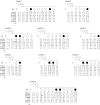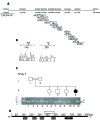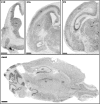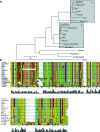The CC2D1A, a member of a new gene family with C2 domains, is involved in autosomal recessive non-syndromic mental retardation
- PMID: 16033914
- PMCID: PMC2563235
- DOI: 10.1136/jmg.2005.035709
The CC2D1A, a member of a new gene family with C2 domains, is involved in autosomal recessive non-syndromic mental retardation
Abstract
Background: The molecular basis of autosomal recessive non-syndromic mental retardation (NSMR) is poorly understood, mostly owing to heterogeneity and absence of clinical criteria for grouping families for linkage analysis. Only two autosomal genes, the PRSS12 gene on chromosome 4q26 and the CRBN on chromosome 3p26, have been shown to cause autosomal recessive NSMR, each gene in only one family.
Objective: To identify the gene causing autosomal recessive NSMR on chromosome 19p13.12.
Results: The candidate region established by homozygosity mapping was narrowed down from 2.4 Mb to 0.9 Mb on chromosome 19p13.12. A protein truncating mutation was identified in the gene CC2D1A in nine consanguineous families with severe autosomal recessive NSMR. The absence of the wild type protein in the lymphoblastoid cells of the patients was confirmed. CC2D1A is a member of a previously uncharacterised gene family that carries two conserved motifs, a C2 domain and a DM14 domain. The C2 domain is found in proteins which function in calcium dependent phospholipid binding; the DM14 domain is unique to the CC2D1A protein family and its role is unknown. CC2D1A is a putative signal transducer participating in positive regulation of I-kappaB kinase/NFkappaB cascade. Expression of CC2D1A mRNA was shown in the embryonic ventricular zone and developing cortical plate in staged mouse embryos, persisting into adulthood, with highest expression in the cerebral cortex and hippocampus.
Conclusions: A previously unknown signal transduction pathway is important in human cognitive development.
Conflict of interest statement
Competing interests: none declared.
References
-
- McLaren J, Bryson S E. Review of recent epidemiological studies of mental retardation: prevalence, associated disorders, and etiology. Am J Ment Retard 198792243–254. - PubMed
-
- Leonard H, Wen X. The epidemiology of mental retardation: challenges and opportunities in the new millennium. Ment Retard Dev Disabil Res Rev 20028117–134. - PubMed
-
- American Pyschiatric Association Diagnostic and statistical manual of mental disorders (DSM‐IV). 4th ed. Washington, DC: American Psychiatric Association, 199439–46.
-
- Curry C J, Stevenson R E, Aughton D, Byrne J, Carey J C, Cassidy S, Cunniff C, Graham J M, Jones M C, Kaback M M, Moeschler J, Schaefer G B, Schwartz S, Tarleton J, Opitz J. Evaluation of mental retardation: recommendations of a consensus conference: American College of Medical Genetics. Am J Med Genet 199772468–477. - PubMed
-
- Wright S W, Tarjan G, Eyer L. Investigation of families with two or more mentally defective siblings: clinical observations. Am J Dis Child 195997445–456. - PubMed
Publication types
MeSH terms
Substances
LinkOut - more resources
Full Text Sources
Other Literature Sources
Molecular Biology Databases
Miscellaneous





